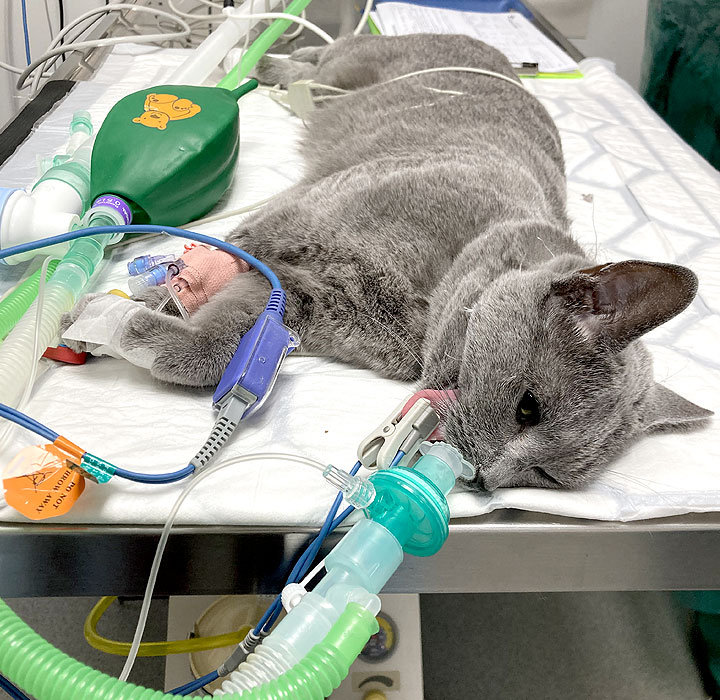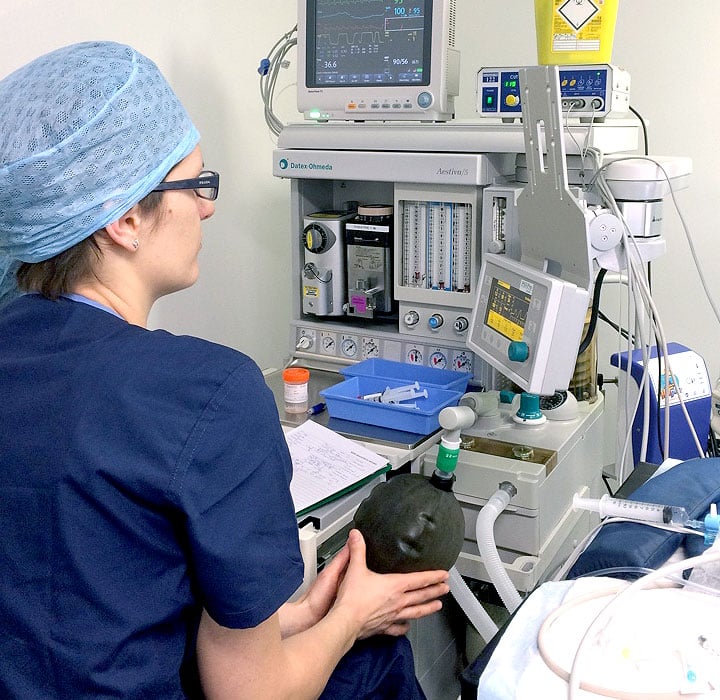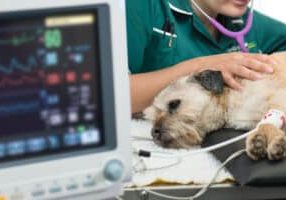
Common small animal anaesthesia myths and misconception
We hope our evidence-based facts will replace common myths and provide enhanced knowledge and confidence regarding anaesthesia in everyday practice.
MYTH: Ketamine is a safe drug for patients with failing cardiac disease
TRUTH: Ketamine increases sympathetic tone, so heart rate, contractility and even blood pressure may increase. There are patients with specific cardiac conditions that would benefit from those effects but the opposite is also possible.
Ketamine may be dangerous and not advised for a patient with hypertrophic cardiomyopathy, where an increased contractility and heart rate may decrease cardiac output and compromise myocardium oxygenation. Furthermore, ketamine may have a direct myocardial muscle contractility depression effect, as seen in research in vitro studies; therefore, ketamine could be potentially catastrophic for a cardiac failure patient or a patient with an exhausted sympathetic drive.
In summary, ketamine is a fairly safe drug due to its wide therapeutic index and sympathetic effect, but there are specific cardiac cases where it can be dangerous. A review of the exact pathophysiology for a specific cardiac condition is advised before ketamine is used in a cardiac patient.
MYTH: Ketamine should not be used for epileptic patients
TRUTH: This statement can be a bit ambiguous. We know that ketamine can increase intracranial pressure and decrease the threshold for seizures, and for that reason, it often gets banned from any anaesthetic protocol for epileptic patients.
Nowadays, we know that when a patient has been in status epilepticus for a while, the classical anticonvulsant GABAergic drugs (benzodiazepines, valproic acid, propofol and phenobarbital) seem ineffective and increasing doses may produce unwanted side effects like cardiorespiratory depression. In this refractory status epilepticus (GABAergic therapy no longer working), ketamine has proven effective due to an increased expression of NMDA receptors in these patients.
So ketamine may be used in epileptic patients but only to treat seizures in specific cases such as a refractory status epilepticus.
MYTH: I can feel the pulse so the blood pressure must be at least 60mmHg
TRUTH: It is impossible to know if a patient becomes hypotensive under anaesthesia unless blood pressure is adequately measured. Unfortunately, not only sick or old patients become hypotensive, but all patients are at risk.
Hypotension is the most common complication in veterinary anaesthesia. Several survey studies in different veterinary hospitals indicated that up to 33% of all anaesthetised patients (dogs and cats) were hypotensive with a systolic pressure lower than 90 or a mean pressure lower than 60mmHg. This research shows that even healthy young patients undergoing elective procedures are susceptible to anaesthetic hypotension.
Generally, there are very few post-anaesthetic complications that can be directly connected to an anaesthetic hypotensive episode, but vital organs such as kidneys may be injured in the process with no apparent clinical signs: more than 75% of nephrons must be non-functional before changes are shown in BUN and creatinine levels. Consequently, blood pressure should be routinely measured for all patients and hypotension addressed adequately should it appear.
MYTH: Of course I monitor my anaesthetised patient, I even have an ECG
TRUTH: ECG is a valuable piece of monitoring equipment used to check for adequate heart electrical activity. It is very useful to determine and monitor heart rhythm and heart rate, but sometimes the information displayed can be misleading.
Myocardial electrical activity is not the same as a beating heart, and an ECG will not provide information on mechanical activity or pumping strength. It is not uncommon for an electrocardiogram to show electrical activity and a fairly regular rhythm for several minutes after a heart has stopped beating. For that reason, ECG must be used wisely and not relied upon as a measure of the circulatory status of our patients.
MYTH: The recovery period is the safest period in anaesthesia, and only a minimal level of monitoring is required; once the vaporiser is off and the patient extubated, the patient should be out of danger
TRUTH: Anaesthesia induction tends to be perceived as the most dangerous time during the anaesthesia process. On the other hand, recovery is commonly seen as the safest time because the patient is no longer under anaesthesia; however, evidence indicates otherwise.
The most recent and biggest veterinary study ever performed in the UK about perioperative fatalities in small animals (CEPSAF) found that deaths occurred during the first 3 hours post- anaesthesia in 47% of the cases in dogs and 61% of the cases in cats. This remarkable finding highlights the importance of the recovery period and reminds us not to undermine it.
Common anaesthetic complications such as hypotension and hypothermia may prevail during recovery, so they should be monitored and treated accordingly. Hypoventilation and hypoxaemia are common findings during the post-anaesthetic period since patients often go directly from 100% oxygen controlled breathing to spontaneous breathing room air with 21% oxygen. Besides, the duration of anaesthetic drugs may vary due to individual differences or body temperature; hence some of the anaesthetic’s clinical effects may linger for a while during the recovery period.
It is recommended to have a recovery room for all patients recovering from anaesthesia or sedation or at least to have a dedicated area in wards with recovery equipment (monitoring, suction, intubation kit, warming devices and oxygen) and dedicated staff where all recovering patients can be allocated and safely recovered.
MYTH: The patient crashed during anaesthesia as it stopped breathing; we had to stop the procedure and wake the patient
TRUTH: Apnoea and respiratory depression are a very common finding and they hardly ever imply an anaesthetic crisis unless intubation cannot be achieved.
Once endotracheal intubation has been achieved, most patients will oxygenate adequately with as little as 1-2 breaths a minute when they breathe 100% oxygen. The apnoea and hypoxaemia caused by propofol/alfaxan induction can be minimised or prevented by a very slow induction and pre-oxygenation.
Occasionally the patient becomes apnoeic or hypoventilates under anaesthesia, usually due to several reasons such as inadequate anaesthetic plane (too deep), nociception response (holding their breath) or following a ‘top up’ of drugs like ketamine or opioids. These episodes tend to be of short duration and will self-resolve once what triggered them has been sorted. On these occasions, the temporary instauration of gentle manual ventilation is necessary to ensure intake of anaesthetic and control adequate oxygen and carbon dioxide levels.
If the patient is not doing well and a crisis is looming, then apnoea appears as a first sign of the imminent arrest. If that is the case, concomitant signs such as absent pulses with progressive loss of end-tidal carbon dioxide will warn the anaesthetist of the impending crisis. The majority of times, respiratory depression or apnoea appearing as a sole sign hardly ever constitutes a true emergency in anaesthesia and can be easily managed as long as the patient is intubated.
See also Mythbusters: Anaesthesia Unveiled Part I


Case Advice or Arranging a Referral
If you are a veterinary professional and would like to discuss a case with one of our team, or require pre-referral advice about a patient, please call 01883 741449. Alternatively, to refer a case, please use the online referral form
About The Discipline
Anaesthesia

Need case advice or have any questions?
If you have any questions or would like advice on a case please call our dedicated vet line on 01883 741449 and ask to speak to one of our Anaesthesia team.
Advice is freely available, even if the case cannot be referred.
Anaesthesia and Analgesia Team
Our Anaesthesia and Analgesia Team offer a caring, multi-disciplinary approach to all medical and surgical conditions.